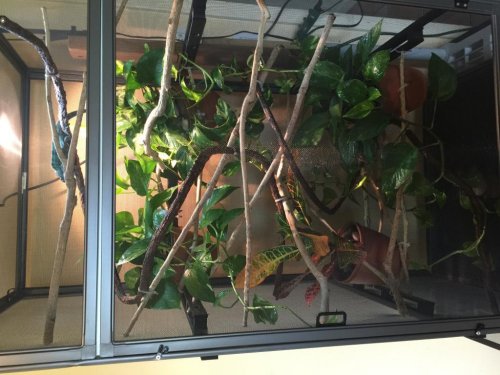Dolphinirium
New Member
Hi guys,
I own for about 1 month a female veiled chameleon (don't know her age but she was still baby when she was given to me) and it's my first chameleon
For some weeks ago I noticed she had something white around 1 of her nostrils. Generally, it goes away during the day and it's more evident in the morning or late in the day.
She has been eating crickets and I notice she has grown, however she didn't change her skin since I have her.
Today I noticed she was puffing more than usual (generally she would just do it when I tried to remove the white thing with a cotton swab), even when she was just sitting there basking.
Sometimes she just puffs up a couple of times but others she puffs up and open her mouth after. Some of those times I heard her hissing, so I don't know if she was mad with me.
I post a couple of photos so you can see what I'm talking about.
Do you think she's healthy or can she have a respiratory infection?
Chameleon Info:
Your Chameleon - Veiled, female, 3 months?, I have her for about 1 month
Handling - Just handled her a couple of times to clean her nose
Feeding - Crickets. I put a few of them in the enclosure and add when it's necessary. However, I cup feed her 1 cricket per day in the morning, so she could get more used to me. I gut-load them with carrots, potato, etc.
Supplements - Calci sepia powder from Reptiles-planet. I use it to dust the cricket I give to her every other day.
Watering - I spray the enclosure 2-3 times/day and I see her drinking the drops from the wall.
Fecal Description - Black/dark brown well formed droppings with white urates. She hasn't been tested for parasites.
Cage Info:
Cage Type - 4 sides screen with back in wood and bottom with substrate. 60(l)x60(w)x120cm(h)
Lighting - Ultrasun 80W mercury vapor lamp from Reptiles-planet. 12h of light with temporization.
Temperature - basking spot around 27ºC and 25ºC on the ground. At night the lowest is about 23ºC. I measure them with a digital probe-type thermometer.
Humidity - Around 53-55% just with the spraying. I measure with a digital probe-type hygrometer
Plants - Hibiscus, schefflera arboricola, ficus benjamina, pothos and another I don't remember the name.
Placement - It's located in a room that most of the time remains the door closed, without fans or air vents. The top is at 1.80m relative to the floor.
Location - Portugal
Current Problem - White stuff around nostril. Possible respiratory infection?
First day at home

Her enclosure in the begining (now it has more branches and plants)







Here are a couple of videos with the white thing on her nose and her puffing and opening her mouth after it.
https://youtu.be/iPIlmZ7hG5k
https://youtu.be/lyDJy_r0ts4
https://youtu.be/BiFdS5Hh4g0
Every advice is welcome
Thank you!
I own for about 1 month a female veiled chameleon (don't know her age but she was still baby when she was given to me) and it's my first chameleon
For some weeks ago I noticed she had something white around 1 of her nostrils. Generally, it goes away during the day and it's more evident in the morning or late in the day.
She has been eating crickets and I notice she has grown, however she didn't change her skin since I have her.
Today I noticed she was puffing more than usual (generally she would just do it when I tried to remove the white thing with a cotton swab), even when she was just sitting there basking.
Sometimes she just puffs up a couple of times but others she puffs up and open her mouth after. Some of those times I heard her hissing, so I don't know if she was mad with me.
I post a couple of photos so you can see what I'm talking about.
Do you think she's healthy or can she have a respiratory infection?
Chameleon Info:
Your Chameleon - Veiled, female, 3 months?, I have her for about 1 month
Handling - Just handled her a couple of times to clean her nose
Feeding - Crickets. I put a few of them in the enclosure and add when it's necessary. However, I cup feed her 1 cricket per day in the morning, so she could get more used to me. I gut-load them with carrots, potato, etc.
Supplements - Calci sepia powder from Reptiles-planet. I use it to dust the cricket I give to her every other day.
Watering - I spray the enclosure 2-3 times/day and I see her drinking the drops from the wall.
Fecal Description - Black/dark brown well formed droppings with white urates. She hasn't been tested for parasites.
Cage Info:
Cage Type - 4 sides screen with back in wood and bottom with substrate. 60(l)x60(w)x120cm(h)
Lighting - Ultrasun 80W mercury vapor lamp from Reptiles-planet. 12h of light with temporization.
Temperature - basking spot around 27ºC and 25ºC on the ground. At night the lowest is about 23ºC. I measure them with a digital probe-type thermometer.
Humidity - Around 53-55% just with the spraying. I measure with a digital probe-type hygrometer
Plants - Hibiscus, schefflera arboricola, ficus benjamina, pothos and another I don't remember the name.
Placement - It's located in a room that most of the time remains the door closed, without fans or air vents. The top is at 1.80m relative to the floor.
Location - Portugal
Current Problem - White stuff around nostril. Possible respiratory infection?
First day at home

Her enclosure in the begining (now it has more branches and plants)







Here are a couple of videos with the white thing on her nose and her puffing and opening her mouth after it.
https://youtu.be/iPIlmZ7hG5k
https://youtu.be/lyDJy_r0ts4
https://youtu.be/BiFdS5Hh4g0
Every advice is welcome
Thank you!



